They’re two different approaches that boaters use to try and protect the prop from being infested with barnacles. No doubt the prop will grow barnacles anyway, but at least maybe they can be slowed down a bit. So that your prop doesn’t look like this ….
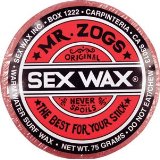 Some people recommend Sex Wax — the stuff surfers use on their surfboards . I guess some of the same principles apply, but I have yet to see a surfboard sit in the water for months on end, so forgive me for being skeptical. However I understand one of the major advantages is it adheres well to the prop and can be re-applied underwater at somewhat frequent intervals, so maybe there’s merit.
Some people recommend Sex Wax — the stuff surfers use on their surfboards . I guess some of the same principles apply, but I have yet to see a surfboard sit in the water for months on end, so forgive me for being skeptical. However I understand one of the major advantages is it adheres well to the prop and can be re-applied underwater at somewhat frequent intervals, so maybe there’s merit.
The other side of the coin is to bag your prop … and we’ve done that, here’s the post, while we were in Bocas Del Toro where it’s strongly recommended if you leave your boat for commuter cruiser season, you bag the prop until you return. The advantages are obvious, you don’t have to have a diver clean your prop every month.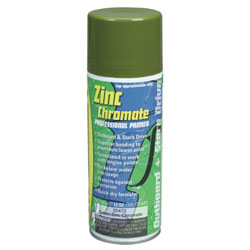
Here in the boatyard, boaters are trying many different approaches to the prop barnacles dilemma. Next to us, Ron plans to coat the prop with Zinc Chromate and then apply a coat … or maybe two … of Pettit ViVid bottom paint – even though he’s not using Pettit ViVid on the rest of the bottom.
But we opted for a different approach this time. In the past, we’ve always just shined up the prop, left it bare and cleaned it ourselves or had our bottom cleaning diver clean it while we were gone.
This time we’re trying Pettit Zinc Barnacle Barrier Coat. According to Pettit’s information:
Zinc Coat Barnacle Barrier is for use only on bare metals such as steel, stainless steel, cast iron, copper, bronze, galvanized steel and lead. It forms an excellent adhesive bond to underwater metals and running gear and inhibits surface corrosion. Because of its smooth, hard surface it will self-clean in service. Zinc Coat can be used above or below the waterline. Do not apply anti-fouling paint over Zinc Coat.
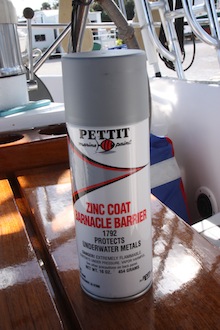 BTW, you can buy it in the West Marine store, as we did, for $35 OR order it online from West Marine for $32; OR order it from Amazon for $25, your choice! 🙂
BTW, you can buy it in the West Marine store, as we did, for $35 OR order it online from West Marine for $32; OR order it from Amazon for $25, your choice! 🙂
It’s a relatively new product and at first, we were concerned about using it on our feathering MaxProp because a rationale human being could conclude that putting paint on a prop that feathers might clog up the movement. So we checked with Fred Hutchinson at PYI Inc. where we bought our prop and THE man if you have questions about setting the pitch or ANYTHING MaxProp. Here’s what Fred replied in his e-mail.
“The Pettit Zinc Barnacle Barrier coat is a good product and the price is right compared to other products on the market. While not a perfect solution (There are none) it works well on any propeller including the Max-Prop. We actually sell it on our website (PYI.com).
When applying just be sure that the propeller is fully assembled so that the paint does not get inside the propeller and onto the bearing surfaces, and don’t paint where the zinc goes as it needs metal to metal contact. You can paint everything except the flat inside face of the blades. But if you paint the propeller with the blade in the feathered position you will not get paint there anyway.”
Here’s the process:
1. Bare metal … the instructions specify to only use it on bare metal. I guess that means NO barnacles. 🙂 So first we had to get ALL the barnacles off and smooth the prop down to bare metal. David spent the longest on this project – first he chipped them off, then used a bit of muratic acid (followed thoroughly with water) to further remove them. Then plain old elbow grease and sandpaper, accompanied by a dremel for tight spots until the prop was shiny and the MaxProp and shaft zincs replaced. Good as new after a bit of maintenance grease
2. Then he had to degrease the prop because in the process of getting adequate maintenance grease into the fittings, it smeared some and we were fairly certain the zinc barnacle barrier wouldn’t adhere correctly to the grease. Moral of this story: if you have a prop that requires grease, it might be a better idea to do the rest of these steps first and THEN apply the grease – but don’t clog up your grease fitting while you’re painting. David put a bit of blue tape in critical areas when he painted the prop. 🙂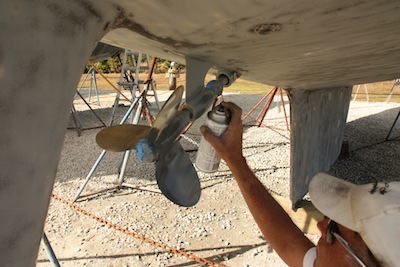
3. The paint process begins. The can specifies three very thin coats of paint sprayed on at least 5 minutes apart. You’ll not the zincs and grease fittings are covered with blue tape. We sprayed the prop and the exterior shaft.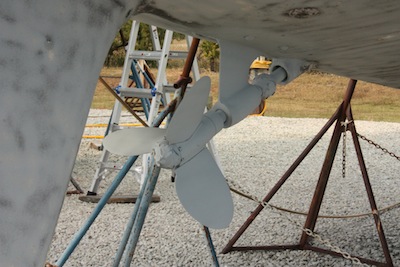 4. Fifteen or so minutes later, our beautiful shiny MaxProp looks like crap with ugly grey barnacle barrier coat on it. We haven’t yet removed the blue tape. But hopefully the barnacles will think it looks like crap too and the zinc content will keep them away from our propeller! If we’re lucky!
4. Fifteen or so minutes later, our beautiful shiny MaxProp looks like crap with ugly grey barnacle barrier coat on it. We haven’t yet removed the blue tape. But hopefully the barnacles will think it looks like crap too and the zinc content will keep them away from our propeller! If we’re lucky!
Anyone else used this paint and have more experience than us? Please leave a comment and share. As far as we’re concerned, it must be working great, the paint’s been on the prop for almost a week and we STILL don’t have a single barnacle … of course, the boat’s not been back in the water yet …. details…. 🙂 Cheers! Jan
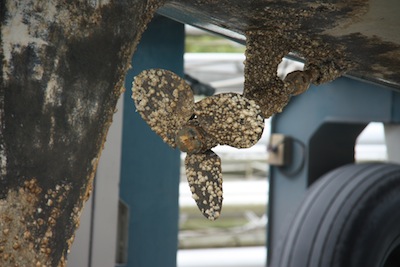











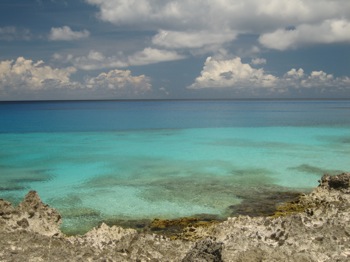

Just a quick note but surfboard wax is used not to make the board “slick” but to make the deck of the board less slippery. As it happens it adheres pretty well to such things as props.
Thanks for the info — you can tell we’re not surfers! 🙂
Just to say that I have been using this for three years now on the East coast of the US and then sailing across the Pacific to Australia and it works extremely well on my Max Prop.